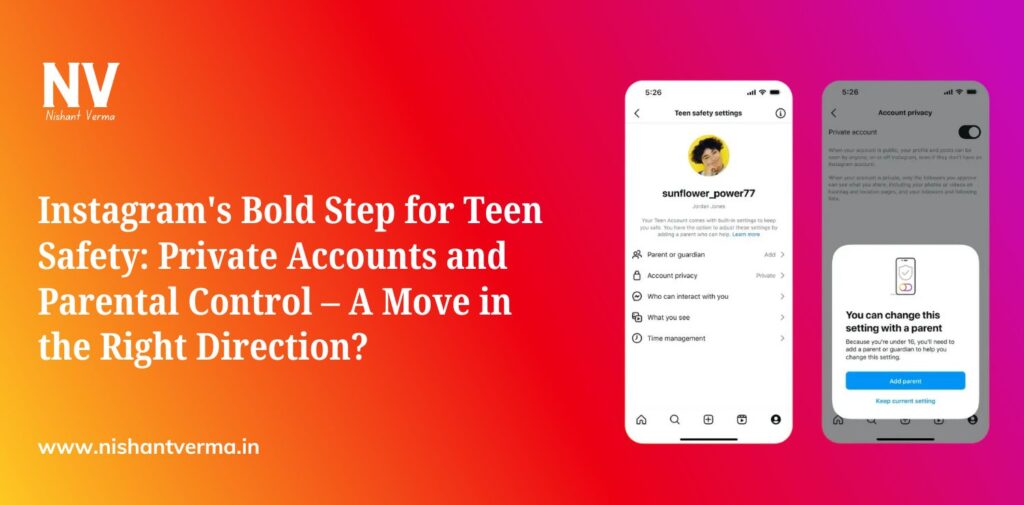In an era where social media is deeply intertwined with the lives of young people, the debate over the balance between safety and freedom on platforms like Instagram is more relevant than ever. On September 17, 2024, Instagram, owned by Meta, introduced significant changes aimed at making their platform safer for teenage users. These changes include making all teen accounts private by default and allowing parents to have more control over their children’s online activities. This move, while welcomed by many, is also facing scrutiny from both privacy advocates and those concerned about teen autonomy.
With the ever-increasing concerns about the safety of teenagers in the digital world, this shift signals Instagram’s acknowledgment of the risks that young users face and its responsibility to address these issues. But what does this change mean for teens, parents, and the broader social media landscape? Let’s take a deep dive into these changes, their potential impact, and the conversation surrounding teen safety on social media.
Instagram’s New Approach to Teen Safety
The newly unveiled product suite primarily targets young users under the age of 18. The tools introduced by Instagram include:
- Private Accounts for Teens: Instagram now automatically sets accounts of users under 18 to private by default. While users can switch to a public account if they choose, the default setting encourages more thoughtful decision-making around their privacy.
- Parental Controls: In a bid to enhance the supervision of teen activity, Instagram has enabled tools that allow parents or guardians to monitor their child’s time on the app, who they follow, and who follows them back. The controls also allow parents to limit screen time, which addresses the growing concern about excessive social media usage.
- Content Restrictions: Instagram’s latest update also includes restrictions on what kind of content can be recommended to teens, particularly content that might be deemed inappropriate or harmful.
While these changes reflect a proactive stance towards child safety, they are not without their critics. Some argue that the measures could impinge on teen independence, while others believe that even more robust policies are required to truly protect young users from the darker sides of the internet.

Why the Push for Change?
The pressure on Instagram to enhance teen safety has been mounting for years. From incidents of cyberbullying and harassment to exposure to harmful content, social media platforms have long been criticized for failing to provide adequate protection for their youngest users. The stakes were raised when multiple reports surfaced about the negative effects of social media on mental health, especially among teens. Research indicated correlations between heavy social media use and issues like depression, anxiety, and body image dissatisfaction.
Furthermore, in recent years, various governmental bodies and child advocacy groups have intensified their scrutiny of social media companies. Concerns about data privacy, harmful content, and the addictive nature of these platforms have prompted calls for stricter regulations. By implementing these changes, Instagram appears to be taking preemptive steps to avoid harsher regulatory intervention and to align itself with the growing global conversation about responsible tech.
The Role of Parents in Digital Supervision
The introduction of parental controls on Instagram signifies an important shift in the social media landscape. Previously, the onus of managing social media activity largely fell on teens themselves, but now, Instagram is making it easier for parents to get involved.
This change comes with its pros and cons. On one hand, parental supervision is critical in ensuring that children are safe from potential online predators, inappropriate content, and mental health risks associated with constant exposure to social media. On the other hand, too much control could stifle a teen’s sense of independence and privacy, which is important for their emotional and psychological development.
Parents will now be able to view a dashboard that provides insights into their child’s Instagram activity, such as the amount of time spent on the app and the list of people they follow. This tool can serve as a vital component in opening up conversations between parents and teens about healthy social media usage.
However, as with any form of parental control, there is a delicate balance that needs to be struck. If used improperly, these tools could lead to conflict between parents and children, especially if teens feel that their privacy is being overly invaded. Therefore, Instagram’s success in this area will depend largely on how well parents can navigate these controls without eroding trust with their children.

Privacy vs. Safety: The Ongoing Debate
While Instagram’s move to make teen accounts private by default is aimed at protecting young users, it also raises questions about privacy and autonomy. Critics argue that teenagers should have the right to make their own decisions about privacy and how they engage with the platform. Social media is, after all, a space where many teens express themselves and connect with peers.
Forcing accounts to be private by default could be seen as a paternalistic move that assumes teens are not capable of making informed choices. However, Instagram’s stance seems to be that safety must come first, especially for minors who may not fully understand the risks of maintaining a public profile.
This tension between safety and privacy is not new. It is a central issue in the broader debate about how much control platforms should exert over their users, particularly when those users are minors. Some privacy advocates worry that increased parental control could further diminish teens’ rights to privacy, not just from the public but from their parents as well.
The Bigger Picture: What’s Next for Social Media and Teen Safety?
Instagram’s decision to make these changes is a clear reflection of the increasing public and governmental pressure on social media companies to take more responsibility for the well-being of their users. As the internet becomes a more regulated space, platforms will likely face growing demands to implement safety features, particularly for vulnerable groups like teens.
For Instagram, the success of this initiative will depend on how well it is received by both parents and teens. If teens feel overly restricted or if parental controls lead to significant conflicts within families, Instagram may face backlash. However, if the platform manages to strike the right balance between safety, privacy, and autonomy, this could become a model for other social media companies to follow.
Moreover, with other platforms like TikTok and Snapchat also popular among teens, it’s likely that these competitors will follow suit in adopting similar safety measures. The question remains: how far can social media platforms go in protecting their users without infringing on their rights? Only time will tell.

Conclusion: A Step Forward, But Not the Final Answer
Instagram’s move to make teen accounts private and allow parents more control over their child’s activity is a significant step forward in addressing the safety concerns that have plagued social media for years. It demonstrates a willingness to adapt and respond to the needs of younger users in a constantly evolving digital landscape.
However, while these changes are a positive development, they are not a catch-all solution. Social media companies, governments, parents, and teens themselves will all need to continue working together to create an environment that fosters both freedom and safety online. After all, as much as Instagram can implement tools and policies, the responsibility for safe social media use ultimately rests on how those tools are used by families.




